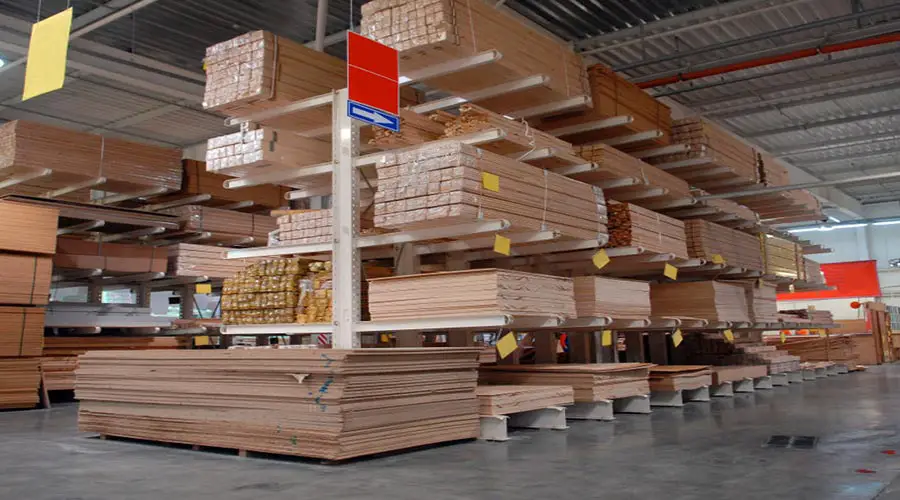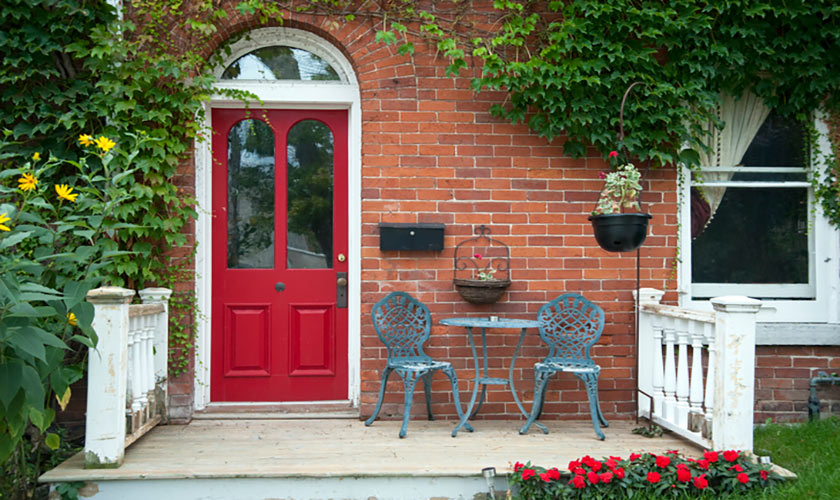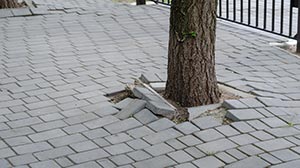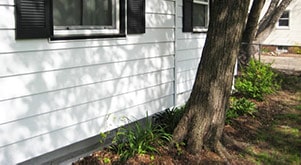
Foundation plants are prevalent among homes with exposed foundations. Exposed foundations are either a result of terrain or a stylistic choice from when the contractor built the house. Nevertheless, many homes require foundation plants to increase curb appeal and shroud exposed foundations, but choosing the best plant can be a challenge, and you may be wondering, what can I plant near my house foundation?
You can plant most plants near your home’s foundation. Plants should not be too big or invasive, such as small trees, shrubs, and ornamental plants. Consider the aesthetics of the plants in combination with the house, and take your time to design a plant layout.
Choosing the fitting foundation plants for your home is essential. The plants should reflect your style while serving the purpose of obscuring exposed foundations and not causing any damage to the house itself. Let’s find out which plants you can use near your home and the best overall foundation plants.
What Are Some Good Foundation Plants?
Foundation plants can make all the difference in the appearance of a home, and using the correct type of foundation plants is critical when deciding which to use.
Good foundation plants should be easy to maintain, relatively short when mature, and well suited for their environment. These plants must grow well close to other plants and not cause any damage to the house. Plant color and seasonality are personal preferences.
Foundation plants obscure raised and visible house foundations. The plants used for this purpose should aid the house’s aesthetics, cover the exposed foundations, and add some color and vibrance to what may otherwise be a dull house exterior.
The plants that achieve this purpose must be selected carefully.
Foundation plants must meet specific criteria to be helpful for this purpose, including:
- the size of the plants when mature
- the way they grow
- how well they grow near other plants and objects
- how easy the plants are to maintain
- how much sun and water do the plants require to grow well
- the overall aesthetics of the house.
Let’s look at some examples of good foundation plants:
Good Foundation Shrubs
- Dwarf Blue Spruce: this shrub is evergreen, grows well in full sun, is cold hardy, and grows 3 -4 feet tall and 4 – 6 feet wide.
- Abelia: grown well in partial shade or full sun, is cold hardy, and grows between 4 and 5 feet tall.
- Rose of Sharon: this shrub grows quickly and requires no pruning. It grows 8 – 12 feet tall, grows well in full sun, and is heat-hardy.
- Pinnacle Hydrangea: easy to grow, and size varies from 3 to 8 feet tall depending on the plant variant. This shrub must not be overwatered. This shrub grows well in partial or full sunlight and is hardy in cool and hot climates.
- Juniper: the Juniper shrub grows 2 feet tall and about 4 feet wide. It is very low maintenance, cold hardy, grows in full or partial sun, is resistant to drought and air pollution, and deters fauna.
Good Foundation Trees
- False Cypress grows in full sun and partial shade. It grows 6 – 20 feet tall and 6 – 6 feet wide depending on the variant, has a pyramidal shape, deters deer, and is heat-hardy.
- Hicks Yew: this tree grows well in full sun or partial shade. It is easy to prune, grows 10 – 12 feet tall and 3 – 4 feet wide, and is cold-hardy.
- Flowering Crabapple: grows 15 – 40 feet tall and 15 – 20 feet wide. It is cold, and heat-hardy and male Flowering Crabapple trees do not produce fruit.
- Arborvitae: this tree is evergreen and produces bright green foliage. It grows 12 – 15 feet tall and 3 4 feet wide. It is cold and heat-hardy and grows well in full sun and partial shade.
- Capitata Yew: this is an evergreen tree that is easy to prune. It grows in full sun to full shade, 3 to 25 feet tall, and 2 to 25 feet wide. It is hardy in medium cold and medium heat.
Good Foundation Ornamental Plants
- Stonecrop: this small plant is easy to grow and simple to maintain. It grows 10 12 inches tall, in full sun, and is cold and extreme heat-hardy.
- Catmint: there are two variations of Catmint that grow in full sun, are 12 – 12 inches tall, and are heat and cold hardy.
- Hosta: this plant grows 11 – 18 inches tall and 28 – 30 inches wide. It is cold and heat-hardy and grows well in full or partial shade.
- Ornamental Onion: there are many variations of this ornamental plant, all of which grow between 15 – 20 inches tall in full sun, are easy to maintain, and grow well in minimum cold and heat.
- Globe Arborvitae: this small shrub is evergreen, grown 1 – 2 feet tall and 1 – 2 feet wide, only requires light maintenance, is cold hardy, and should not be over-watered.
How Far Should Plants Be From Foundation?
The placement of foundation plants with the house is vital for protecting the house and the growth and longevity of the plants. If the plants are too close to the home, it may cause damage to the house, and the plants may not grow well.
The proximity to foundation plants grown with the house depends on the plant’s size and root system. Plant large shrubs and trees a minimum of 5 feet from the house. 2 -3 feet away is suitable for smaller plants.
Plant foundation plants such as large shrubs, bushes, and trees close enough to the house to serve as foundation plants but not so close that their leaves are less than 5 feet from the house when they are mature.
You may plant smaller plants such as small shrubs and ornamental plants closer to the house. You can plant smaller plants closer to objects as they do not take up as much space. Small plants should not grow to be closer than 2 feet from the house to ensure that the plants grow well and cause no damage to the home.
The plants in a foundation bed should not be close enough to one another to hinder the growth of the plants. When planting multiple plants, be sure to research plants that grow well in tandem with other plants.
Another option is to grow dense plants, such as hedges, as then only one plant will be necessary to cover a larger area.
Hedges and shrubs grow well in tandem with trees as the leaves grow above the shrubs, which means that neither plant encroaches on one anothers’ sunlight requirements.
Before digging for plants or beds, it is vital to contact a local utility company to doa preliminary inspection and location of underground utility lines such as power lines and water mains.
This hotline is an excellent resource for finding a company to perform an underground utility inspection.
What Is A Good Foundation Plant Layout?
Foundation plants work well to conceal exposed foundations, increase curb appeal, and improve a house’s aesthetic appearance. For this reason, it is vital to intentionally design the layout of your foundation plants to look good.
Foundation plant bed design and layout are almost limitless. When designing a foundation bed, You must consider plant and leaf color, plant size and shape, and plant seasonality.
The layout depends on the house, the plants chosen, and the preferences of the homeowner.
When designing a foundation planting bed or choosing the plants to conceal a houses’ foundation, consider the form of the plants as much as their function.
Choose the plants for the foundation bed according to their shape, foliage color, how well they grow together, seasonality, the root systems of the plants, and how well they complement the overall aesthetics of the house.
When designing the layout of the foundation plant bed, there are multiple considerations to make.
Some key layout elements to remember are:
- The overall shape of the planting bed is the most vital aspect to consider.
- The outline of the plants is visible from any angle. The design changes the house’s appearance the most.
- The form of the plants. The form is how the shapes of the various plants correspond with each other and the home.
- The structure of the planting bed, including raised foundation planting and permanent features of the planting bed.
- The perceived texture of the planting bed is essential. The way plants look regarding their roughness or smoothness affects the overall look of the foundation plants.
- One of the most vital aspects is color. Consider the color of the plants and their foliage and any other features within the foundation planting bed.
Remember that the foundation plants that you use determine the way the house looks. The plants also affect the appearance of the entire property and set the tone for the home’s appeal.
The layout of the foundation plants must be conducive to the house shape and size, the surrounding garden, and the rest of the flora around the house.
The shape of the house is essential, as the planting bed can change the perceived shape of the building. Be sure that any planting beds you design improve the shape and contour of the house rather than detracting from it.
The final consideration is the sun. The sun exposure on the various sides of the house is different. Some sides of the house receive more sunlight than others. Your plant choices depend on the conditions they require for adequate growth.
If one side of the house receives no sunlight, but the other sides do, planting the same plants in the shaded area as the sunny areas will not work well. The shaded area will lead to one side of the house being bare with an empty planting bed.
Be sure to take the time to properly design the layout of the planting beds and the type of plants that you will use for foundation plants before undertaking this project. Consider the size, styles, shapes, and colors of the plants and the overall shape of the planting area.
How To Choose The Best Foundations Plants For You
The design and layout of the foundation plants are vital, but the plants themselves are more crucial. The plants you choose should appeal to you and match the house decor.
Choose foundation plants based on the way they look, your budget, their requirements for effective growth, and the level of maintenance that they require. It is also essential to check with the local authorities for information about invasive and harmful alien plant species, as You should avoid these.
Choosing the best foundation plants for you begins with the amount of time and effort you can or are willing to set aside for maintaining the plants used. Foundation plants cannot go unmaintained, as they matter to the aesthetics and appearance of the entire house. The house will look untidy and unappealing if the plants are not maintained.
If you have the time, high-maintenance plants can be beneficial. Otherwise, try to plant low-maintenance plants instead.
The next part of the decision process should be the way the plants look, including:
- the way they look in and out of season
- the color of the bark or stems of the plants
- the color of the foliage
The color of the plants should be complementary to one another and to the house.
A vital consideration to make is the growing requirements for the plants that you choose. If the area where you live experiences frigid temperatures, be sure to select plants that can handle the cold. The same is true for hot climates and heat-hardy plants.
Temperate climates are more forgiving than plants, but rainfall is an essential factor as well. If your area experiences large amounts of rainfall, do not use plants that struggle in very wet beds. Some plants do not do well in dry beds, so research the plants you use thoroughly.
Understand the needs of the plants that you use, consider the color and shape of the plants and their maintenance requirements, and then the only other consideration to make is your budget.
Following these steps will help you to find the perfect foundation plants for you, but be sure to take enough time to carefully consider every aspect of the plants and their environment before choosing your plants.
Can Foundation Plants Damage The House?
Planting trees, shrubs, and ornamental plants so close to a house is a great way to improve the house’s aesthetics and conceal exposed foundations, but it is crucial to consider the potential damage that such a process can cause.
Foundation plants close to the house can cause structural damage to the house. Roots may damage infrastructure such as plumbing, and plants too close to home may cause mold and rot. Some plant roots may even cause structural damage to foundations.
According to The International Association of Certified Home Inspectors, the roots of larger plants such as trees can damage the foundations of a house by worsening pre-existing cracks in the foundation.
Larger root systems from foundation plants can uplift the foundations of a home, causing severe structural damage that requires costly repairs. Roots may even remove so much moisture from the soil that the building eventually begins to sink into the ground.
Plumbers and home inspectors warn against plants being too close to homes for the potential damage they may cause to the plumbing and underground infrastructure of the house.
Tree roots can be a severe problem. Consider placement before planting any large plant close to a house, especially against the house’s foundation.
Foundations plants also pose other problems such as fire hazards, fall hazards, and these plants often make the perfect point of entry for rodents and other animals to gain access into a house.
Be careful which plants you use and where you plant them when investing in foundation plants to avoid any unforeseen damages and potentially costly repairs.
Conclusion
Foundation plants are ideal for improving the overall look of a house and for concealing exposed foundations.
In the end, any plant can be used as a foundation plant as long as the plant is not too big, too wide, and the roots are not too invasive.
The ideal foundation plants are easy to maintain small trees, shrubs, and ornamental plants that do not grow too quickly and are suitable for the climate where you live.
Be sure to design the foundation plant beds’ layout carefully and choose the plants carefully based on how they look, their requirements, and how much maintenance they require.
Choose the right plants that are both appealing and won’t harm the home’s structure. Be sure to choose carefully, take your time to plan the plants and the layout, and you will find the ideal plants for your foundation bed!
References
https://www.thespruce.com/pictures-of-foundation-plantings-4069724
https://www.provenwinners.com/learn/top-ten-lists/10-easy-foundation-plants-front-your-house
https://experthomereport.com/how-far-should-plants-be-from-a-house-read-before-planting/
https://blueskyplumbing.com/trees-and-plants-that-cause-plumbing-problems/







